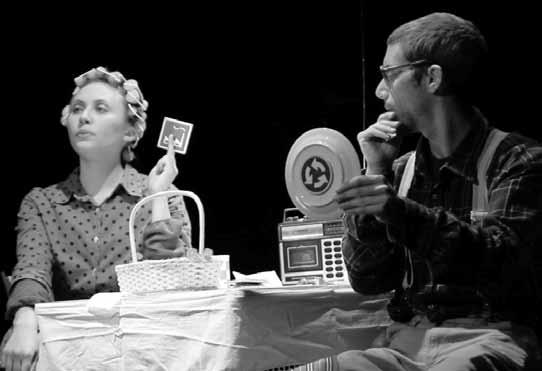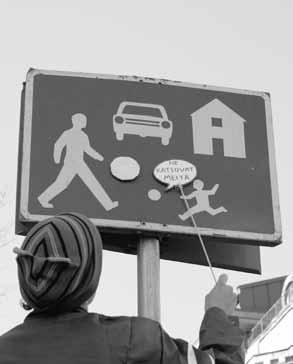
4 minute read
Puppetry of the public space
Puppets of the Public Space
Afternoon in the center of Turku. In the middle of a parking place stands a no-parking traffic sign, not a very rare sight, until we notice that this traffic sign moves on two legs in a peculiar dance. Not very far away from the parking place, a city’s maintenance worker is climbing a ladder to a another traffic sign, and starts to present a story, attaching thought and speech bubbles as in comic books to the figures in the sign. Has the city gone mad? These and many more exceptional moments were performed as a part of traFika, a performance project created by the Finnish puppeteer Ishmael Falke from the Sixfingers Theatre company and the Swedish dancerchoreographer Sandrina Lindgren. It all started from a little walk around in the snow covered streets of Turku. Opening our eyes to perceive the surroundings, we wondered how commercial the public space has become, when we realized that the only colorful objects in the urban space which are NOT for sale are the traffic signs. This was the first time we understood traffic signs as a public piece of art. A big, invisible universal puppeteer Traffic signs are the ABC of urban movement. They order the directions and the rhythms of how people and objects move, they create certain situations and moods in one part of the city, and others in another place. They are, in fact, the one big, invisible puppeteer of the city. In spite of minor differences, traffic signs can be quite universally understood. It seems that they are based on a common way in which people - regardless of culture - are visually reading messages. A common visual language, that is, which makes traffic signs a perfect platform for non text based puppet theatre. This universal theme has been a natural starting point for a project as international as traFika. The project was initiated as part of Mikropatia, a year long micro theatre urban art happening, and through Mikropatia also a part of Europe’s cultural capital’s official program in Turku. Following working periods both in Turku and Stockholm, a demo performance was presented in November 2011 in TIP -fest, Turku’s international puppetry festival. In February 2012 traFika was invited to perform in Clipa Aduma visual theatre festival in Tel Aviv.
Advertisement

Animating the city
Photo: Daniel Brosovni
traFika on the street and on the stage (above). Actors Sandrina Lindgren and Ishmael Falke.
Photo: Maiju Tainio
the definition of puppet is not restricted to objects built especially for a certain show. Traffic signs can be made into puppets, characters and puppetry stages even if they are still stuck in the ground. Through games and experiments we created a series of short solo performances which are traffic sign specific (as in the examples in the beginning of this article). While for the unprepared passers by they became surprising situations, these solos were also connected to each other and performed as scenes of a guided tour throughout the city center. The traffic sign of a factory can become a smoking cigarette, while the P of the parking sign can become a smoking pipe. By using these and other symbols in new contexts we play with the way people perceive their surroundings. This is where contemporary puppetry meets urban animism, and this is also the point where it is very easy to become insane.
From the streets to the stage
Having played along with traffic signs outside, we started to search for ways to use this form of visual communication as an element of storytelling and as a source of original movement on the stage. We also found out that traffic signs can be a creative tool for working on the dramaturgy of a performance; when putting them down on the table they become like tarot cards, which suggest numerous lines of stories and their interpretations. Gradually, we came upon a story sad and funny at the same time. And because it is sad and funny at the same time, it has to be true. traFika tells of an elder couple who lost all possibilities to communicate with each other, except – through traffic signs. After years of mutual misunderstanding the couple developed a complex and comprehensive system, in which by the help of the traffic signs they quarrel, argue, remember the past years and above all – keep a good distance. One evening, as they sit at their kitchen table, something strange happens: the traffic signs take over the conversation, drive the couple to the most bizarre situations and makes them cross their red lines. Going out again from the theatre to the street, it feels now impossible for us to see traffic signs as plane objects – we keep seeing little stories everywhere.
Coming up performances in Stockholm Fringe festival 22. & 25.8.2012 as well as in Tehdas Teatteri 9.,10.,11. & 16.11.2012.
Guided traFika’s street performances as part of the Martti! -festival 10.11.2012 in Turku, and in the spring of 2013 traFika travels from Turku to Barcelona for a period of experimentation, development and performances.










